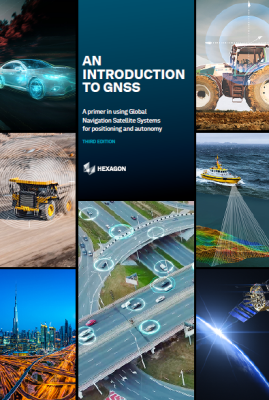Hexagon’s Autonomy & Positioning division announced the release of a third edition update to their reference book titled “An Introduction to GNSS: A Primer in Using Global Navigation Satellite Systems for Positioning and Autonomy.” Written by industry experts at Hexagon, the third edition includes updates to the various GNSS constellations (GPS, GLONASS, BeiDou, Galileo, and more), recent technology advancements to enhance positioning, navigation, and timing (PNT) accuracy, and a new chapter on the growing field of automotive autonomy.
Contents

The book contains nine chapters covering everything from basic GNSS concepts to the latest GNSS applications and equipment. There are four appendices, including a list of acronyms, GNSS glossary, standards, and references. The most complex topics are covered in the beginning of the book, such as the steps involved in using GNSS to determine time and position to the end-user application, including satellites, propagation and reception from multiple GNSS satellites. This provides the basis for upcoming chapters that cover more advanced concepts, such as GNSS error sources, how to resolve these, sensor fusion, and GNSS threats including spoofing, signal blockage, and interference. A separate, new chapter on autonomous vehicles and how positioning can help replace human error with the ability to navigate safely is followed by a list of GNSS applications and current equipment.
Why read this book
This freely available eBook is recommended for people new to Global Navigation Satellite Systems for positioning and autonomy. The inclusion of an entire chapter on automotive autonomy indicates how important precise positioning already is for the automotive industry. The last chapter which briefly covers other industries that rely on satellite positioning shows that the possibilities of this technology are endless.
The book covers many technical and complex concepts and terms. In only 100 pages, it is impossible to cover all of them in-depth, so the authors chose to offer a high-level overview. The authors managed to cover a complex subject in a short text that explains its subject matter very well. The many illustrations with schemes and tables are an important factor why this book succeeds as an attractive and well-written primer on GNSS technology.
There are also some minor issues with the text. For example, the sequence of the chapters is a little strange: ending a book with an overview of GNSS applications makes little sense. These examples would work better as an introduction or as examples throughout the other chapters. Also, the final chapter repeats information from the chapter on automotive autonomy that comes right before it.
Although the book comes with the Hexagon logo, it is by no means about its technology or products. The focus lies on explaining theoretical concepts and technological solutions used for solutions that require positioning and autonomy. It contains valuable and practical information such as a comparison of GNSS correction method accuracy set against a baseline (a common term to indicate the distance from a base station to a rover) to choose the right solution for a certain application, and factors to consider when selecting GNSS equipment.







